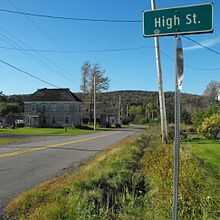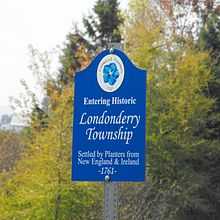Londonderry, Nova Scotia
Coordinates: 45°28′30.7″N 63°36′08.7″W / 45.475194°N 63.602417°W

Londonderry is an unincorporated community located in Colchester County, Nova Scotia, Canada, formerly called Acadia Mines. A bustling iron ore mining and steel making town of some 5,000 in the late 19th century, the population today stands at around 200.
History

The iron ore seams that encouraged development, originally thought to be enormous, proved to be small, shallow, and very expensive to mine. That, coupled with poor management decisions and failed experiments with rotary type ovens as well as low world steel prices, spelled the demise of the iron and steel industry in Londonderry. The fatal blow to the community came with a destructive fire in 1920 which destroyed a large portion of the town.[1] The mine operations were foreclosed in 1924 and the town never recovered thereafter.[2] The once vast ruins of the former steel mill were torn down and sold as scrap during the scrap metal drives of World War II.
General information
The CN main line runs through Londonderry Station, about two kilometers east of the village of Londonderry.
Lakeshores at Sutherland's Lake and Folly Lake, only a 10 to 15 minute drive away, are sought-after cottage destinations for residents of nearby Truro, Amherst, Moncton, and Halifax.
Many residents of Londonderry are employed in the nearby Debert Industrial Park and at the Ski Wentworth ski resort, nestled in the Cobequid Mountains, about 20 minutes north of Londonderry along Trunk 4. Londonderry currently has two churches: the Londonderry Station Community Church (also known as the Thirsty Church Project), and St. Ambrose Catholic Church. The Acadia Mines United Church was closed in 2010.
Settlement

Early settlers
Those who settled Londonderry Township included the following individuals:[3]
- Barnhill, John; of Lake, Donegal; resident of Londonderry/Onslow
- Clark, John; of Tamlaught Finleggan, Derry
- Cochran, Daniel; of ?Derrykeychen, Antrim
- Crawford, Joseph; of Rathmelton, Donegal
- Henderson, William; of Rathmullan, Donegal
- Mahon, John; of Rosses, Donegal; resident of Londonderry
- McClean, Anthony; of near Letter Kenny, Donegal; resident of Londonderry
- McNutt, Benjamin Bar; of Killmacrene, Mauagh, Donegal
- McNutt, John; of Tullyachnish, Derry
- McNutt, William; of Mavagh, Donegal; resident of Onslow
- Moore, William; of Fahan, Donegal
- Morrison, John;of Ry Tollaghebegly Donegal; resident of Londonderry
- Patton, Mark; of Fosghan Vael, Derry; resident of Cumberland
- Ross, Andrew; of Belreshain, Antrim
- Smith, Robert; of Cahery, Drummacose, Derry
- Spencer, Robert; of Clanda Horky, Donegal; resident of Londonderry
Notable residents
- Laurie Davidson Cox (1883–1968), leading American landscape architect.
- Frank Parker Day, writer, taught school there
- Robert McElhinney (ca 1747–1831), Irish-born political who represented Londonderry Township in the Nova Scotia House of Assembly
- Archibald McLelan (1824–1890), Lieutenant Governor of Nova Scotia
- James Meissner (1896–1936), World War I flying, recipient of two Distinguished Service Crosses.
- Thomas Fletcher Morrison (1808–1886), sailor, farmer and political figure in Nova Scotia
- Doris Petrie (1918–2000), Canadian film and television actress
See also
References
- ↑ Newspaper clipping, May 31, 1920, Nova Scotia Archives and Record Management
- ↑ Foreclosure notice, April 25, 1924, Nova Scotia Archives and Record Management
- ↑
External links
| ||||||||||||||||||||||||||